Ukraine’s military has faced a shortage of planes over the last two years, with most of its prewar stocks being outdated Soviet-era models. NATO and other countries have sent help in the form of older models or maintenance and spare parts for existing aircraft. Russia, on the other hand, has a larger and more advanced air force. However, new planes are on the way to help Ukraine, with promises of U.S.-made F-16 fighter jets from countries like the Netherlands and Belgium committing to send 30 F-16s from its stocks. These aircraft will help Ukraine balance out Russia’s numerical advantage in the air and relieve pressure on its ground forces.
The F-16s will allow Ukraine to engage Russia’s air force, launch munitions, and fire long-range missiles, as well as use Western weapons designed for F-16s. There have been debates among Ukraine’s partners about how these weapons should be used, with some policymakers concerned about triggering escalation with Moscow. Restrictions on the use of donated weapons raise questions about their effectiveness and Ukraine’s ability to use them effectively against Russian forces. In addition to F-16s, Sweden has promised to send two ASC 890 surveillance aircraft, adding an extra dimension to Ukraine’s future airpower with airborne early warning and control capabilities.
Donations mean that Ukraine will likely receive two AEW&C aircraft and several dozen F-16s, though some may be held in reserve for contingencies, training, or spare parts. The timing of the arrival of these aircraft in Ukraine remains uncertain, with some expected to be delivered by the end of the year. While jets are not a guarantee of victory for Ukraine, they play a crucial role in its defense strategy. Gaining more freedom in the air is essential for stabilizing front lines with Russia and potentially regaining lost territory. Training with donated F-16s is currently taking place in Romania, with Belgium and other countries leading efforts to send aircraft to Ukraine.
Aircraft donations have sparked a debate among Ukraine’s partners about how the weapons should be used, with some advocating for restrictions on their use against Russian territory. Ukraine’s own weapons, including attack drones, are limited in stock and effectiveness against well-defended targets. The donated F-16s and ASC 890 surveillance aircraft will enhance Ukraine’s air defenses and provide broader awareness of potential threats. Sweden’s decision to send the ASC 890 instead of Gripen aircraft allows Ukraine to focus on integrating one new type of aircraft at a time.
In conclusion, the donation of F-16s and surveillance aircraft to Ukraine will bolster its air defense capabilities and help counter Russia’s air force superiority. The arrival of these aircraft will provide Ukraine with more options for engaging Russian forces and potentially regaining lost territory. While jets alone are not a guarantee of victory, they are a crucial component of Ukraine’s defense strategy. The ongoing debate about how donated weapons should be used underscores the complex geopolitical considerations at play in Ukraine’s conflict with Russia.


